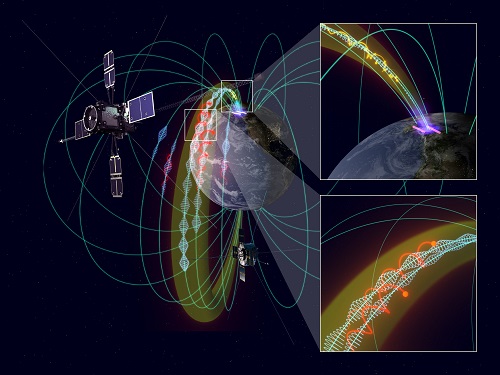Success in Visualizing the “Propagation Path” of Electromagnetic Waves from Space to Ground
Dec 09, 2021
Elucidating, through international collaboration, the 50,000 km journey taken by electromagnetic waves using simultaneous multipoint observations
 Using data on electromagnetic (EM) waves and plasma particles measured simultaneously via multiple satellites, an international collaborative research group has discovered the existence of invisible “propagation path” of EM waves and elucidated the mechanism by which EM waves propagate to the ground. The group led by Associate Professor Shoya Matsuda from Kanazawa University, includes Professor Yoshiya Kasahara from Kanazawa University, Professor Yoshizumi Miyoshi from Nagoya University, and representatives of the University of Colorado (USA); University of Minnesota (USA); JAXA Institute of Space and Astronautical Science; Tohoku University; Kyoto University; Kyushu Institute of Technology; Los Alamos National Laboratory (USA); University of New Hampshire (USA); National Institute of Information and Communications Technology; National Institute of Polar Research; and the University of Alberta (Canada).
Using data on electromagnetic (EM) waves and plasma particles measured simultaneously via multiple satellites, an international collaborative research group has discovered the existence of invisible “propagation path” of EM waves and elucidated the mechanism by which EM waves propagate to the ground. The group led by Associate Professor Shoya Matsuda from Kanazawa University, includes Professor Yoshiya Kasahara from Kanazawa University, Professor Yoshizumi Miyoshi from Nagoya University, and representatives of the University of Colorado (USA); University of Minnesota (USA); JAXA Institute of Space and Astronautical Science; Tohoku University; Kyoto University; Kyushu Institute of Technology; Los Alamos National Laboratory (USA); University of New Hampshire (USA); National Institute of Information and Communications Technology; National Institute of Polar Research; and the University of Alberta (Canada).
EM waves that occur naturally in geospace cause the formation and the dissipation of radiation belts surrounding the Earth as well as the emission of auroras. These EM waves propagate along the magnetic field lines of the Earth in both the northern and southern hemispheres. An overall three-dimensional (3D) image of how EM waves propagate in space has not been realized until this international collaborative study.
The international collaborative research group, by linking the four observation points of the Japanese “Arase”, US “Van Allen Probes”, Japanese “PWING (study of dynamical variation of Particles and Waves in the INner magnetosphere using Ground-based network observations) Project”, and Canadian “CARISMA (Canadian Array for Real-time Investigations of Magnetic Activity) magnetometer array”, succeeded in centrally capturing how EM waves are generated in space as well as how EM waves propagate to the ground. They elucidated that the EM waves propagate a distance of approximately 50,000 km along straw-shaped “propagation path”, and energize the cold plasma during their long journey.
In this study, the international collaborative research group was successful in capturing, in 3D, the EM waves propagating in space using a multipoint observation network, which is useful in understanding dynamics of the space environment driven by EM waves. By linking thesee high-performance satellites and ground-based observatories developed in different countries, it was possible to visualize the space environment in 3D, which promises to be a major step toward improving the accuracy of space weather forecast in the future.
The results of the study will be published in the online version of “Geophysical Research Letters” on December 8, 2021, 9:00 (Eastern Standard Time).

This study was supported by Grants-in-Aid for Scientific Research (14J02108, 16H06286, 17H06140, 20K14546 and 20H01959) of Japan Society for the Promotion of Science (JSPS) and JSPS Bilateral Open Partnership Joint Research Projects (JPJSBP120192504). The CARISMA array is funded by the Canadian Space Agency. Science data of the Arase satellite were obtained from the ERG Science Center operated by ISAS/JAXA and ISEE/Nagoya University (https://ergsc.isee.nagoya-u.ac.jp/index.shtml.en).
[Journal title]
Geophysical Research Letters
[Paper title]
Multipoint Measurement of Fine-Structured EMIC Waves by Arase, Van Allen Probe A and Ground Stations
[Authors]
Shoya Matsuda1, Yoshizumi Miyoshi2, Yoshiya Kasahara1, Lauren Blum3, Christopher Colpitts4, Kazushi Asamura5, Yasumasa Kasaba6, Ayako Matsuoka7, Fuminori Tsuchiya6, Atsushi Kumamoto6, Mariko Teramoto8, Satoko Nakamura2, Masahiro Kitahara2, Iku Shinohara5, Geoffrey Reeves9, Harlan Spence10, Kazuo Shiokawa2, Tsutomu Nagatsuma11, Shin-ichiro Oyama2,12, Ian Mann13
1 Graduate School of Natural Science and Technology, Kanazawa University, Kanazawa, Japan
2 Institute for Space‐Earth Environmental Research, Nagoya University, Nagoya, Japan
3 Laboratory for Atmospheric and Space Physics, University of Colorado Boulder, Boulder, CO, USA
4 School of Physics and Astronomy, University of Minnesota, Minneapolis, MN, USA
5 Institute of Space and Astronautical Science, Japan Aerospace Exploration Agency, Sagamihara, Japan
6 Graduate School of Science, Tohoku University, Sendai, Japan
7 Graduate School of Science, Kyoto University, Kyoto, Japan
8 Graduate School of Engineering, Kyushu Institute of Technology, Kitakyusyu, Japan
9 Space Science and Applications Group, Los Alamos National Laboratory, Los Alamos, NM, USA
10 Institute for the Study of Earth, Oceans, and Space, University of New Hampshire, Durham, NH, USA
11 National Institute of Information and Communications Technology, Koganei, Japan
12 National Institute of Polar Research, Tachikawa, Japan
13 Department of Physics, University of Alberta, Edmonton, AB, Canada
[Published on]
December 8, 2021, 9:00 (Eastern Standard Time)
[DOI]
10.1029/2021GL096488
[Link]
https://agupubs.onlinelibrary.wiley.com/doi/10.1029/2021GL096488

